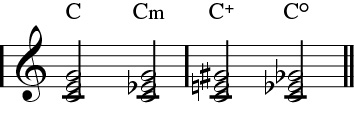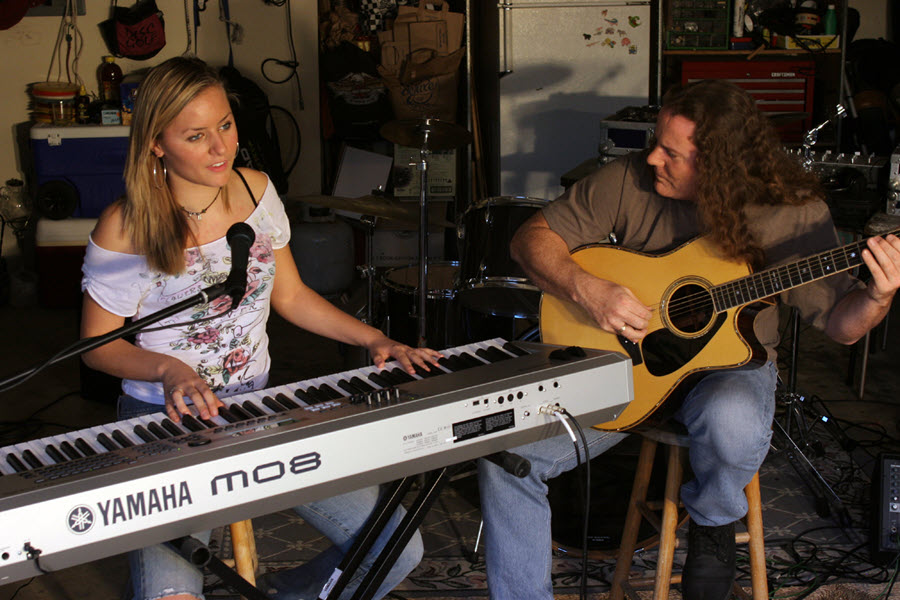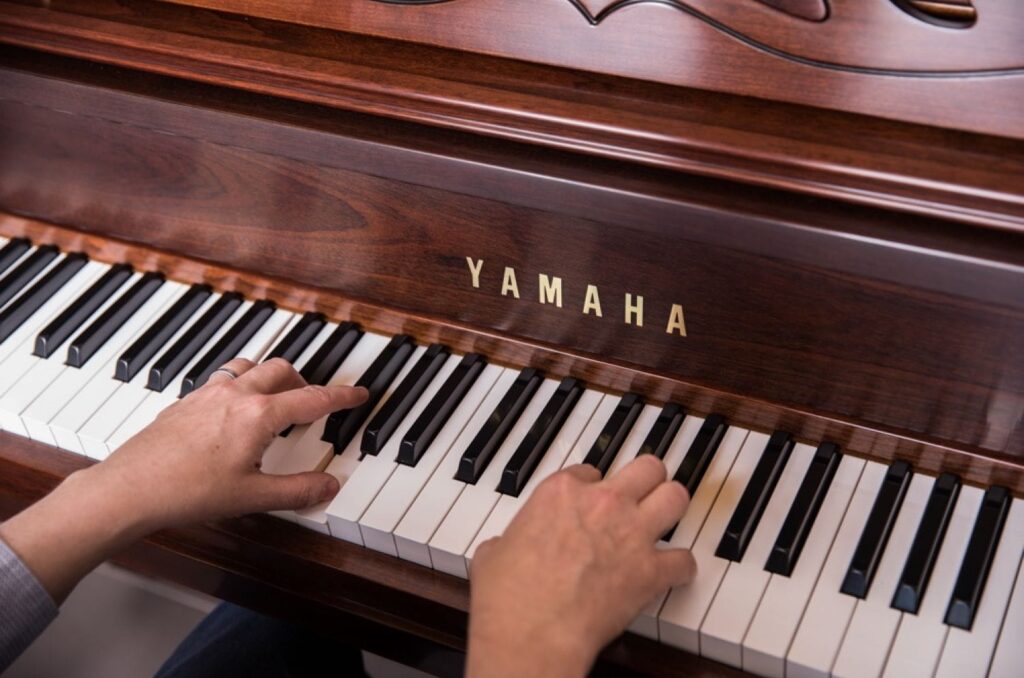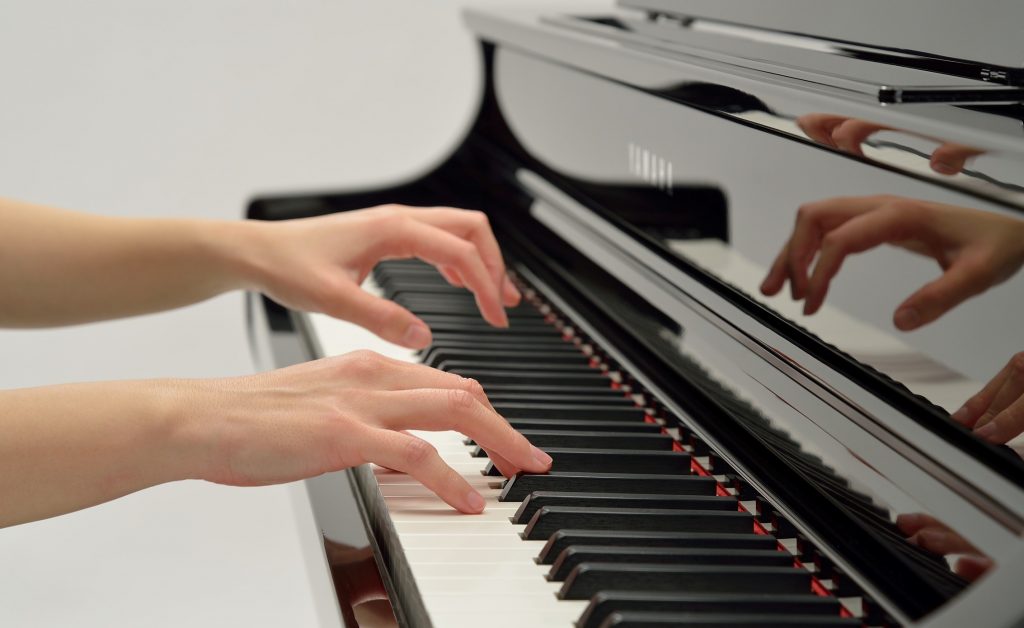Tagged Under:
The Basics Of Chordal Harmony
Understanding chords and harmonic function.
As keyboardists, we get to provide the harmonic backdrop for the music we perform with singers and with other instrumentalists. Having a deep understanding of chords, voicings and harmonic movement allows us to do our job with confidence, creativity and color.
What’s A Chord?
A chord is simply three or more notes that are played at the same time. In Western music we tend to build those chords by stacking notes in intervals of a third (i.e., three or four half-steps). The main types of triads (three-note chords) are as follows:

The first chord shown is a C Major, built on the first, third and fifth tones of the C Major scale. If we lower the third by a half-step we get the second chord, a C minor. The third chord shown is called C augmented (as you can see, the plus sign is commonly used as an abbreviation), and it takes the major triad and raises the fifth a half-step. The final chord shown is called C diminished (commonly indicated, as you can see, with a superscripted “O”), and it has both a lowered third and fifth.
Listen to this audio clip to get the sound of each chord type in your ears:
To understand how these chord types occur in Western music, we can stack thirds on each of the notes of a major scale to get the following triads:

The Major triad occurs on the first, fourth and fifth steps of the scale. Does this remind you of anything? A blues chord progression, perhaps?
The minor chord occurs on the second, third and sixth steps of the scale, and the diminished chord occurs on the seventh step. Being able to discuss chords using this numbering system of scale steps is an important skill, since musicians often describe a chord progression this way, using the Roman numerals I, ii, iii, IV, V, vi and vii.
Note: When we discuss chords, we use the terms “root” (the fundamental note the chord is built on), “third” and “fifth” even though not every chord is built on the root note, or starting note of a given scale. For example, I can talk about the D minor triad as being built on the second step of the C scale, and say D is the root, F is the third, and A is the fifth of that chord. So don’t be confused by the difference between the numbering of the scale steps, or by the stacked notes of any given chord.
Building Up
If we add one more tone from the scale (a “scale tone”) — the one a third above the triad — we get what’s called a seventh chord:

But there’s an interesting twist here: If you compare these larger chords to the triads we previously built, you can see some important differences. For example, the new tone in the I and IV chords is a major third (that is, 4 half-steps) higher, which is why they are called major seventh chords, but the new tone in the V chord is a minor third higher (that is, 3 half-steps). This combination of a major triad with a minor, or lowered, seventh is called a dominant seventh chord — an important chord type we’ll be talking more about shortly. The new tones in the ii, iii and vi chords are also a minor third higher, but the combination of a minor triad with a lowered seventh is called a minor seventh chord. Finally, the new tone in the vii chord is a major third higher, and is called a half-diminished, or minor seventh flatted fifth chord.
There is an inherent tension in the dominant seventh chord, created by the third and seventh tones (the B and the F) that “want” to resolve back to the root and the third of C (the I chord of the scale we are basing our example on, which is called the key center):

The first measure shows a G7 (G Dominant seventh) chord resolving back to a C triad using an inversion of the G7 chord (an inversion is a rearrangement of the notes of a chord) — in other words, a V7 resolving back to the I chord. The second measure shows just the third and seventh of the G7, which wants to resolve to the root and 3rd of the C chord by moving inward. The third measure simply flips the order of the third and seventh of the G7 to resolve to the C by moving outwards. Listen to the natural way this tension and release occurs in this audio clip. You’ll find that it “makes sense” to our ears:
That tension inherent in a V7 dominant seventh chord “wanting” to resolve back to a I chord is a centerpiece of Western harmony, and we’ll be using that a lot in the harmony lessons coming in future “Well-Rounded Keyboardist” blog postings.
Harmony In a Minor Key
Every major key has a related minor key, which starts on the sixth step of the major scale, and the same concepts can be applied there. For example, C Major has a relationship to A minor, and we call that key the relative minor. The illustration below shows how they share both the same notes and key signature (in this case, no sharps or flats).

Notice that the V chord is no longer Major in this situation, and when made into a seventh chord it would not be a dominant seventh. Many early composers created melodies that raised the 7th tone of the scale — which we call the harmonic minor scale — to solve this issue (after all, that’s why it’s called “harmonic!).

Those chords can be extended into seventh chords to get the following:

This gives us back the same V7 (dominant 7th) chord that can resolve back to the i chord:

This audio clip demonstrates three ways you can use inversions to play a V7 resolving to the i chord in a minor key:
As we build on these principles, we’ll start to encounter even more colorful chords, such as the i chord (called a minor major 7th — a minor triad with a major third note stacked above it), the III chord (a major seventh with a sharp, or augmented, fifth) and the vii chord, which is a (fully) diminished seventh chord (that is, a diminished triad with another minor third stacked above it).
All audio played on a Yamaha P-515.
Check out our other Well-Rounded Keyboardist postings.
Click here for more information about Yamaha keyboard instruments.














